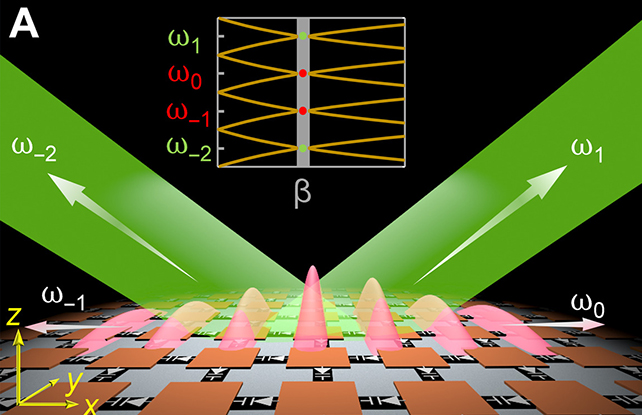Scientists are still getting to grips with the ins and outs of strange materials known as time crystals; structures that buzz with movement for eternity. Now a new variety might help deepen our understanding of the perplexing state of matter.
Just as regular crystals are atoms and molecules that repeat over a volume of space, time crystals are collections of particles that tick-tock in patterns over a duration of time in ways that initially seem to defy science.
Theorized in 2012 before being observed in the lab for the first time just four years later, researchers have been busy tinkering with the structures to probe deeper foundations of particle physics and uncover potential applications.
In this latest study, a new kind of 'photonic' time crystal has been created. Operating at microwave frequencies, it is able to neaten and amplify electromagnetic waves, promising future applications in wireless communication systems, laser development, and electronic circuits.
"In a photonic time crystal, the photons are arranged in a pattern that repeats over time," says lead author Xuchen Wang, a nano engineer from the Karlsruhe Institute of Technology in Germany.
"This means that the photons in the crystal are synchronized and coherent, which can lead to constructive interference and amplification of the light."
In addition, the research team found electromagnetic waves traveling along surfaces could be amplified as well as waves from the surrounding environment.
At the center of the research is a 2D approach based on ultra-thin sheets of artificial materials known as metasurfaces. Previously, research into photonic time crystals has been through bulk 3D materials: making and studying these materials is hugely difficult for scientists, but the switch to 2D means a faster and easier route to experimentation – and to finding out how these crystals might be applied in real world settings.
While simpler than full 3D structures, they share some important characteristics with photonic time crystals and can mimic their behavior – including the way they interact with light. It's the first time that photonic time crystals have been shown to amplify light in this particular way and to such a significant extent.

"We found that reducing the dimensionality from a 3D to a 2D structure made the implementation significantly easier, which made it possible to realize photonic time crystals in reality," says Wang.
While real world applications are still some way off, the approach of using 2D metasurfaces as a way of producing and examining photonic time crystals is going to make this kind of research much more straightforward in the future.
The discovery of electromagnetic wave amplification along surfaces, for example, could eventually help to improve the integrated circuits found everywhere from phones to cars: communication within these circuits would potentially be faster and more seamlessly.
Then there are wireless communications, which can suffer from signal decay over distance (which is why you might not be able to get Wi-Fi at the top of your house). Coating surfaces with 2D photonic time crystals promises to improve this situation.
"When a surface wave propagates, it suffers from material losses, and the signal strength is reduced," says physicist Viktar Asadchy from Aalto University in Finland.
"With 2D photonic time crystals integrated into the system, the surface wave can be amplified, and communication efficiency enhanced."
The research has been published in Science Advances.
